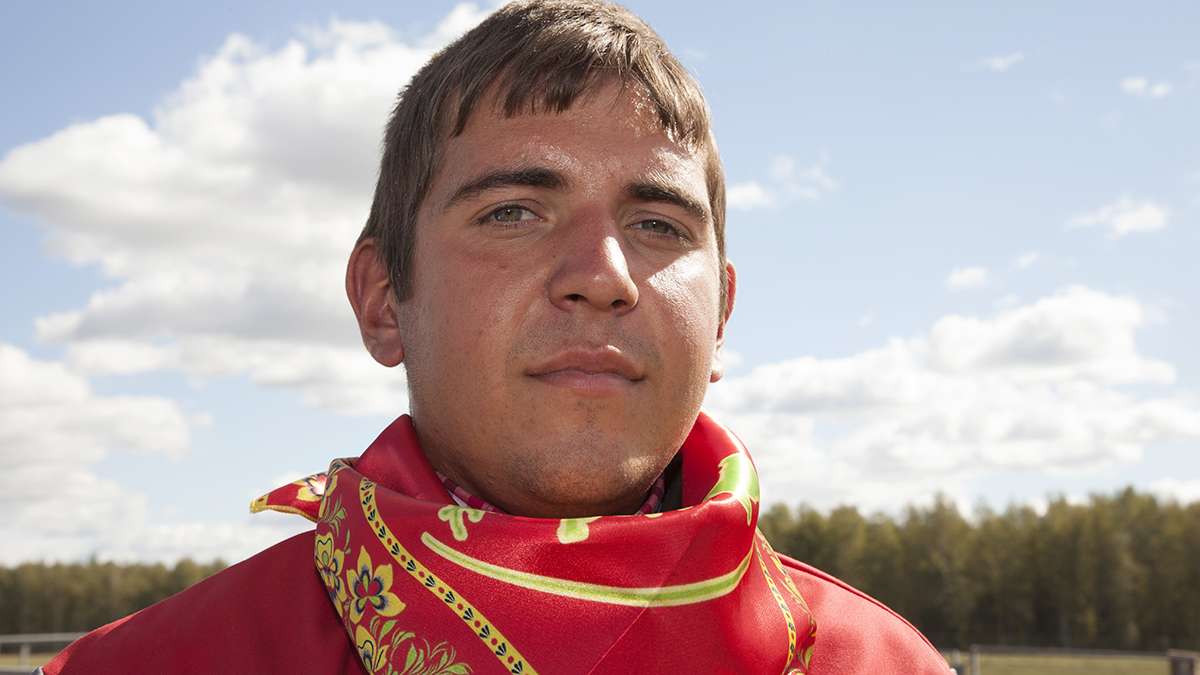Russian cowboys learn to wrangle a brand new beef industry
Listen 15:35-

Sergei Shilin, a Russian cowboy, has been with Miratorg for nearly four years. He says the work is becoming a lifestyle for him. (Irina Zhorov)
-

Shawn Weekes, of Texas, is one of a handful of American cowboys currently working on Miratorg farms and helping train Russian cowboys. (Irina Zhorov/WHYY)
-

Miratorg provides uniforms for its workers. (Irina Zhorov)
-

Family and friends in the audience cheered for the rodeo teams. (Irina Zhorov)
-

Yevgeniy Landik, one of Miratorg's up and coming Russian cowboys, participated in the rodeo for the first time this year. His team placed third. (Irina Zhorov)
-

A rodeo participant on the day before the rodeo, in between practice runs. (Irina Zhorov)
On a beef ranch called Ledenevo, in the Bryansk region of Russia, about 300 miles southwest of Moscow, everything is brand new. The farm opened just a year ago and the tractors, the administrative buildings, the gravel work roads, the fencing, somehow even the cows themselves, sparkled. On a sunny day this fall, a rodeo overshadowed the farm’s regular operations.
As far as rodeos go, everything here resembled an American rodeo, but the proceedings were just a little different. The cowboys entered the arena to patriotic songs similar to rodeos in the U.S., but here, one song was about how America should return Alaska to Russia. In another, a man sang about Russia’s untapped mightiness. “Give me a horse and a sword,” the chorus blared out of a formidable sound system installed for the event.
No swords here, but plenty of horses. And tons of people who came to watch. They brought signs and applauded their teams as they struggled to rope steers in the arena.
The Russian Rodeo embodied more than entertainment. It was a cacophonous celebration of a fledgling beef industry clawing its way into the Russian countryside. It was also part of a larger national goal to gain self-sufficiency with food production.
A company called Miratorg, the largest Russian beef producer, hosted.

Biggest herd in the world
Miratorg is a chicken and pork producer that started acquiring land – mostly fallow fields abandoned when the Soviet Union fell apart – for a beef project around 2010. The company had to pull up weeds and even young forests that had started to overtake the fields and plant imported grasses in their place. Shortly after, Miratorg started populating that land with thousands of cows flown or shipped in from places like the U.S. and Australia. In the U.S., it took more than a hundred years of breeding to make animals specifically for beef. Russia has only had dairy cows, which don’t make good meat. By bringing fine-tuned genetics, the Russians skipped a huge step in building up a herd.
By copying the structure of Western beef operations, Miratorg skipped more steps. Miratorg is single-handedly trying to create an American-style beef industry, but in a very condensed time period. It now has about 400,000 cows, the largest herd in the world. The company has had to build fences in a country without any, to train veterinarians, and to also import everything from horses and grass seed to tractors. But the hardest part of managing this immense operation is not the science or the planning.
It’s finding workers. Cowboys.
So the company imported some of them, too.
One of them, Shawn Weekes, has been in Russia for two years. He’s a fourth-generation, Montana-born cowboy with a great, big mustache, Western boots, a hat, and a tucked in button up shirt. “I grew up doing this,” he said. “A rope was actually my first toy.”
He’s worked on ranches all over the U.S. but the growth of Miratorg, from zero to the largest herd in the world, stood apart. “I’ve never seen anything grow this fast. Ever. And sometimes it kind of set me back a little bit, like, whoa, let’s slow this train down a little bit. But this is their program and this is what they want, so I just try to help them,” Weekes said.
His job is teaching locals to cowboy. The new hires, mostly young men from nearby villages, have no experience. Most of them have only seen cowboys in black and white movies.
“The difference is they’re starting out from scratch, there’s only a handful of us here to teach all these people how to do this,” he said.
Miratorg now employs 1,000 Russian cowboys, though they call them ‘operators.’ Weekes says it’s been hard translating cowboy work ethic and skills to the operators. He’s had a hard time convincing operators to start work early, before the heat, to stay until the job is done, to follow his instructions. Once, some operators showed up on bikes, instead of horses, to move a herd. So he teaches the operators to ride horses, to use a lasso, to doctor calves, but also to accept the long work hours, the can-do attitude of a dedicated cowman, and the love for the animals.
Uncontrollable passion
At the rodeo, the grounds were like one big advertisement for beef. Cooking demonstrations sent smoke into the sky, helpful tour guides in denim shirts stitched with the words ‘Russian rodeo’ showed visitors how the farm works, a couple of cleaned up show calves gleamed in the sun.

In the U.S., a steak starts with a calf that spends about a year on pasture, proceeds to a feedlot, then a processing facility, then a store or restaurant. Each step is its own industry with a myriad of players. Because none of that has existed in Russia, Miratorg encompasses all of those sectors under one giant roof and has had to build them up, along with the ranches. Hence the cooking demos – they kind of have to train steak eaters, too.
In the arena, a team called Mglinn rode out to a relatively toned down folk song and people in the stands chanted to encourage them.
In the U.S., rodeos started as friendly competition between ranches. “My cowboys are better than your cowboys, my horses are better than your horses. And so it kind of was the same idea here,” said Weekes.
The big difference here is Miratorg owns all of the competing ranches and employs all of the participants.
It took an operator named Yevgeniy Landik several tries but he finally roped the steer to great cheering. He looked nervous angling up to the calf, but afterwards he said he wasn’t.
“The Americans taught us that we have to take this just like work,” Landik said. “So that’s what I did. I went out as if to work, did my job, and left. That’s it. Nothing to worry about, you just have to show them how you work in the field.”
Landik is one of Miratorg’s up and coming operators, young, quiet, serious. He wore a floral silk kerchief around his neck. The company gave the operators kerchiefs with traditional Russian designs on them for the rodeo. They’re a Russian take on the silk bandanas American cowboys wear. Just like the operators are their take on cowboys.
“A Russian cowboy is impatient, they’ve got uncontrollable passion. Once a Russian cowboy gets impassioned, there’s no stopping him. That’s how we are. The Russians are like ‘hurry hurry faster, I’ll get him first, c’mon, c’mon,’” Landik said.
He got back on his horse for the next event, but his words – ‘hurry, hurry, faster, faster’ – echoed in the farm around him.
In a kind of throwback to the Soviets’ penchant for ambitious plans, Miratorg’s proposal calls for doubling the number of their farms and cows. It’s a big investment and they haven’t turned a profit, yet. They started selling meat two years ago but beef, particularly the marbled steaks Miratorg wants to produce, is incredibly expensive for the average Russian, and so the market is limited.
Small steps
Perhaps measuring success instead starts with a man named Sergei Shilin. He’s the company’s most convincing operator.
On rodeo day, he wore a hat given to him by an American when he caught his first steer by the hind legs. Another American gifted him his boots for working well together.
He’s from a nearby village and used to work at a dairy operation, which fell apart. He said he thought he knew cows, but his first day at Miratorg, as an operator, was difficult.
“Right away they gave me a horse. It was an American horse, I couldn’t control it the same way as our Russian horses. Not knowing how to work with them we got two bulls stressed out and we needed to transfer them section to section, the bulls came at me,” he said.
His wife made him go back the next day and he progressed quickly from there. After two years as an operator, he took a job as a trainer. Now he teaches riding and roping skills at a recently opened cowboy academy. Miratorg opened a whole academy to train operators because they’re hiring so many so fast and it’s all just so so new. Shilin loves it.
“For me, this is becoming a lifestyle,” he said. “At the current time, this cowboy work, it’s a lifestyle, I cherish it. God willing, when my son grows up I want him to be a Russian cowboy, too. He’s four months now. But in the near future, I want him to be a cowboy.”
As the rodeo wound down, the participants received their prizes, about 100 dollars to buy Western wear. That might be a little hard because there is nowhere local to buy it.
Parachutists, who the DJs called ‘aerial cowboys,’ floated down into the arena with Russian flags, Miratorg flags, nearly clipping the fences upon landing.
All this for some steaks. But of course the steaks are so much more than that – a symbol of success, of Russia’s ability to take care of its own.
How are the steaks, anyway?
“To tell you the truth, I haven’t ever tried the steak yet, have never tried the meat,” Shilin said.
“I just haven’t had the chance,” he said. “Especially, the marbled steaks, for me for now, it’s too expensive. I can’t afford to buy a kilo of this meat. I think in the future I will try it with my family.”
So, for now, a Russian cowboy is also one who doesn’t eat steak.
Irina Zhorov reported this story as part of the UC Berkeley-11th Hour Food and Farming Journalism Fellowship.
WHYY is your source for fact-based, in-depth journalism and information. As a nonprofit organization, we rely on financial support from readers like you. Please give today.






